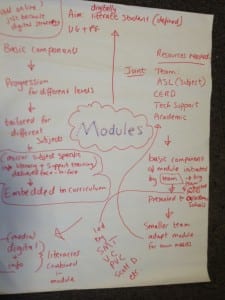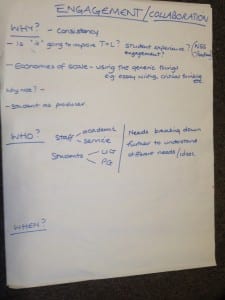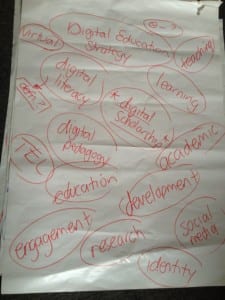

 Doug suggests eight elements of digital literacies. If we interpret elements as characteristics this gives some idea of their complexity but not what they are. Maybe we need to look at categories. For example media digital literacies, information digital literacies, web digital literacies etc. But there are also digital literacies at subject level where the requirement for arts, science, food manufacture, nursing and social work might all derive from different learning styles and professional ways of working. Add digital scholarship, digital pedagogy and digital identity and it’s clear you can have too much of a digital thing – there are too many digital literacies. We need an alternative taxonomy; a way to simplify the complexity.
Doug suggests eight elements of digital literacies. If we interpret elements as characteristics this gives some idea of their complexity but not what they are. Maybe we need to look at categories. For example media digital literacies, information digital literacies, web digital literacies etc. But there are also digital literacies at subject level where the requirement for arts, science, food manufacture, nursing and social work might all derive from different learning styles and professional ways of working. Add digital scholarship, digital pedagogy and digital identity and it’s clear you can have too much of a digital thing – there are too many digital literacies. We need an alternative taxonomy; a way to simplify the complexity.
‘Digital literacy is a condition not a threshold.’*
Doug repeated this several times. But it’s only a condition if you are in the right place and time for it to happen. A shared starting point is necessary to begin the conversation. We might need thresholds after all. In Social Work in a Digital Society, I use threshold concepts to present digital literacies as social practices Social Work in a Digital Society Threshold Concepts Here each successive layer of understanding increases knowledge and alters practice. A threshold is like a starting line – a place to begin.
I think I get the concept of digital literacies as a condition – being prepared to accept a digital dimension to your life and having the confidence to explore new digital landscapes – but access and support is necessary as are specific goals and outcomes. In the way you need the alphabet to read, so you need basic tools to become digitally literate. The tools are the thresholds. We need to look at the building blocks of digital literacies like file formats and management, attachments and file sizes before RSS, building mashups and remixing code.
Maybe the best way to grasp digital literacies is to see them as the online equivalents of everything we do off-line.
To encourage and support confidence with digital ways of working means engaging with the affordances, finding the tipping points or thresholds which make a difference. These will be different for everyone but they are already out there. We just need to find them; like Doug’s quote from William Gibson ‘ The future is already here, but is unevenly distributed.’
—————————————————————————————————————————————–
* Martin, A. (2006). ‘Literacies for the Digital Age: A Preview of Part 1’ in A. Martin and D. Madigan , eds, Digital Literacies for Learning. London: Facet Publishing, pp .3–25.
